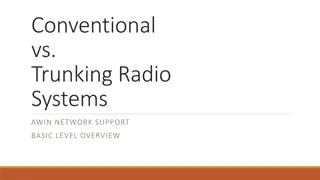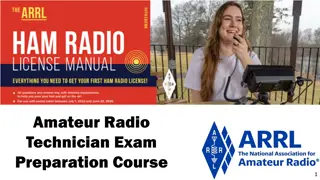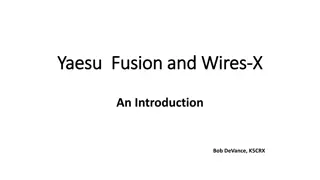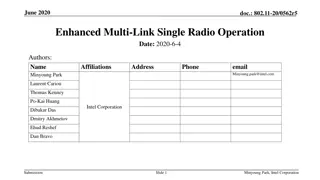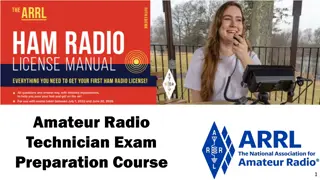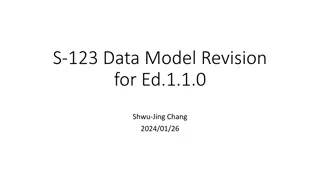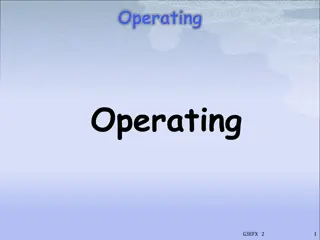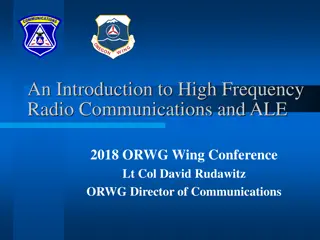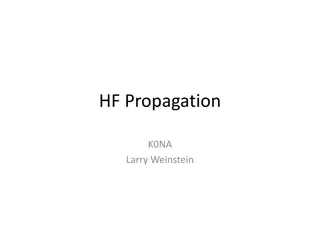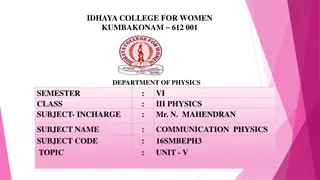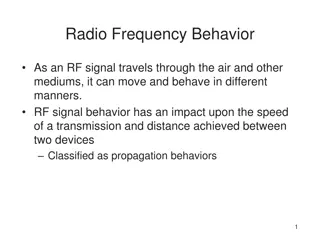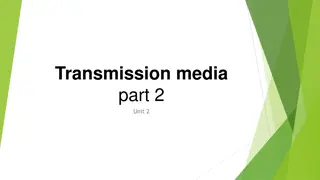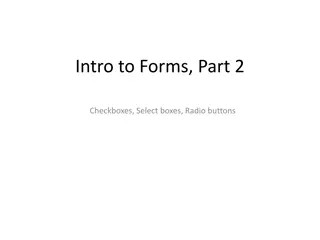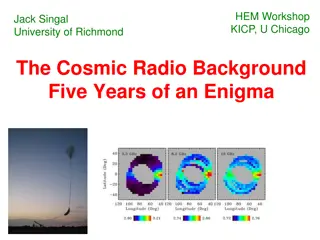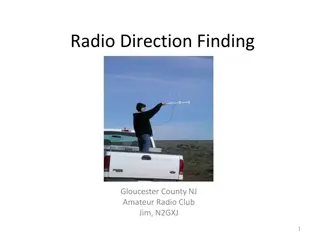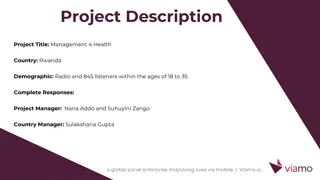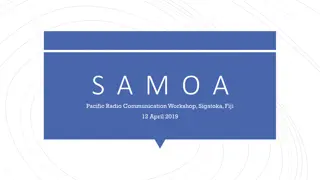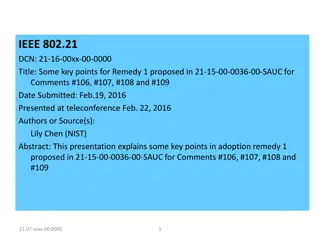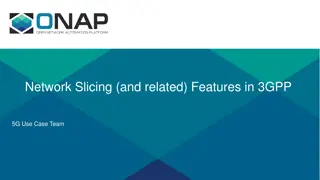Understanding AWIN Network and Radio Communication Basics
Learn about the AWIN network, P25 standard, radio terminology, and why radios are crucial for first responders. Discover the significance of AWIN in providing reliable statewide communication and the role of radios in saving lives. Explore the basics of radio usage, etiquette, and the electromagnetic spectrum. Gain insights into the importance of good communication in emergency situations and how AWIN operates within the UHF spectrum.
Download Presentation

Please find below an Image/Link to download the presentation.
The content on the website is provided AS IS for your information and personal use only. It may not be sold, licensed, or shared on other websites without obtaining consent from the author. Download presentation by click this link. If you encounter any issues during the download, it is possible that the publisher has removed the file from their server.
E N D
Presentation Transcript
Basic Radio Usage AWIN Network Support
Table of Contents What is AWIN? What is P25? What are Radios? Why are Radios Important? Basic Radio Terminology Radio Etiquette How to Use a Radio (Handheld/Portable) Hands-On Questions
What is AWIN? The statewide, multiple site, digital 700/800 MHz trunked communications system using the P25 Standard. AWIN provides statewide operations, within the coverage area of the system for public service entities.
What is AWIN? AWIN provides a reliable, statewide means of communication for the state s first responders. The AWIN system consists of over 100 tower sites and over 27,000 authorized radios. AWIN is monitored 24/7/365 to ensure that it is available whenever the first responder needs it.
What is P25? The standard for the manufacturing of interoperable digital 2-way wireless communications products. All P25 Equipment: Must demonstrate compliance Meet the needs of public safety Be Interoperable with other P25 Equipment
What are Radios? The definition of radio is: The transmission and reception of electromagnetic waves of radio frequency, especially those carrying sound messages
What are Radios? The electromagnetic spectrum consists of everything from: X-Rays UV Light Infrared Light Visible Light Microwaves FM Radio AM radio
What are Radios? As for AWIN We fall into the UHF (Ultra High Frequency) part of the spectrum. Specifically we are in the 700 and 800 MHz bands.
Why are Radios Important? Good, reliable communication save lives. All first responders/emergency personnel have radios or access to radios, either through AWIN, through their own radio system, or another agency.
Why are Radios Important? What about cell phones? Cell phones are not public safety grade (yet). Cell phones do not have to comply to P25 or other public safety standards (yet). Cell phone towers tend to be the first to get congested in an emergency. Usually due to call volume/wireless internet usage.
Why are Radios Important? What about cell phones? A call to another person on a cell phone does not broadcast to multiple individuals. Calls to 911 on a cell phone might not reach your local 911 center. They could roll-over to another county, jurisdiction, or (if you are near the state border) another state. Emergency calls on cell phones do not have priority on cell networks (yet).
Basic Radio Terminology Radio Radio ID/AWIN ID Radio Alias Tower Coverage/Coverage Area Talk Group Mutual Aid Channel (MAC) Talk Group Dragging Push to Talk (PTT) Wide Area Trunking/Trunking
Basic Radio Terminology Radio The device assigned to you from your department that is used for emergency communications. Can be: Handheld/Portable Mobile Base Station/Console
Basic Radio Terminology Radio ID/AWIN ID Unique ID (usually 7 digits) that allows your radio to be on AWIN. These have to be approved and applied for through AWIN. Each radio must have a unique ID Duplicate IDs are not allowed and can hurt communications.
Basic Radio Terminology Radio Alias This is what you want your radio to show when you make a call on it. Examples are: SALI S 202m Means Saline County Sheriff s Office Car# 202 (Mobile Radio) SALI S 15p Means Saline County Sheriff s Office Radio# 15 (Portable) PULA E 1p Means Pulaski County Office Of Emergency Management Radio# 1 (Portable)
Basic Radio Terminology Tower The physical location where the signal your radio receives is broadcast from. Each tower has 3 identifiers on it. A name (I.E. Roosevelt, White Oak, Lonoke) A Site Identifier (I.E. A-02, H-03, A-10) A Tower Number (I.E. 5, 28, 61) This is what will show up in your radio to tell you what site you are connected to.
Basic Radio Terminology Coverage/Coverage Area The area that the tower is capable of broadcasting to. This can be reduced due to: Issues at the tower site Scheduled outages (Preventative Maintenance) Bad antenna on the radio Radio is placed/being used in a bad location Terrain
Basic Radio Terminology Talk Group Usually, and incorrectly, called a channel. Allows you to talk to others on the same group as yourself.
Basic Radio Terminology Mutual Aid Channel (MAC) A Talk Group that is state-wide for events and/or emergencies. Given out and assigned through Arkansas Department of Emergency Management (ADEM). 24 Hr Number 501-683-6700 Each and Every Radio on AWIN has access to these via the Command & Control Template or the ASUG Template.
Basic Radio Terminology Talk Group Dragging Dragging is when a talk group is being used across the radio system and is not part of the incident/area they are listening in to. A trunked (AWIN) radio system can not tell when a radio is just listening It assumes all affiliated radios are equally important and needs the recourses. This just listening will use up resources at each tower it crosses to get the message/PTT to you.
Basic Radio Terminology Push to Talk (PTT) Dual Meanings 1) Generally the largest physical button on the side of the radio that allows you to talk to others via the radio. 2) It is also the term used to determine usage on AWIN by how many times you used the radio and how long.
Basic Radio Terminology Wide Area Trunking/Trunking Wide Area Trunking means that your local AWIN tower is able to allow your radio to talk to other radios in the state that are not on the same AWIN tower. If your radio says Trunking or Out of Wide Area this means that your radio will only talk to radios that are on the same tower as you.
Radio Etiquette The International Radio language is English. Unless you are licensed to speak in other languages. You cannot speak and listen at the same time. Do not hold the PTT button down unless you are planning to talk
Radio Etiquette Do not interrupt Unless it is an emergency Do not respond if you are not sure the call is for you.
Radio Etiquette Never transmit sensitive, confidential, financial, or military information. Unless the transmission is secure. If you are unsure always assume that it is not secure. Perform radio checks to ensure your radio is in good working condition. Do these typically once a month Should only take one call and last for around 5 - 8 seconds.
Radio Etiquette Memorize locations and aliases of persons that you communicate with regularly. Think before you speak. Do not say inappropriate things you do not know who is listening or recording what is being said. Do speak clearly and stray away from abbreviations unless they are industry standard ones.
Radio Etiquette Know the 4 Golden Rules of Radio Communication: 1 Clarity 2 Simplicity 3 Brevity 4 Security
How to use a Radio (Handheld) Live Demonstration


